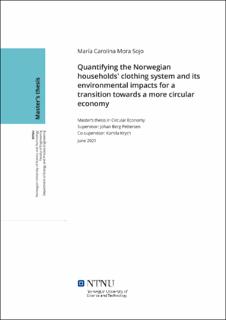| dc.description.abstract | Norway has the ambition to be at the forefront of the transition towards a Circular Economy.
To achieve this the country needs to drastically increase its circularity metric, which in 2020
indicated that only 2.4% of the total amount of materials, input to the economy every year,
were cycled back. In addition, previous analyses of the Norwegian consumption have
identified household consumption as one of the main contributors to Norway’s environmental
footprint. Within their consumption, clothing has stood out as one of the commodities driving
their environmental impacts.
The clothing industry has been recognized for its linearity, which increases the pressure on
the resources been used, and links the industry to environmental problems such as climate
change, and chemical toxicity. This has made necessary to call for a disruptive change in the
industry. Increasing clothing utilization and their lifespan, together with new business model
that can satisfy the clothing needs in a more sustainable way, have been highlighted among
the most relevant strategies to achieve this change. The potential of these strategies lies in
their capacity to close, slow or narrow down the loops in the system, decreasing the demand
for new garments, and consequently the environmental impacts associated to them.
Therefore, aiming to have a better understanding of the Norwegian households’ clothing
consumption, this master’s thesis investigates the flows of clothing within Norway, and its
environmental impacts for the year 2018. This is done using a Material Flow Analysis (MFA),
as this tool provides a systemic approach to identify the flows and processes within the
system. In addition, MFA allows to reach a level of detail that enables the analysis of the
composition of these flows, which is highly relevant to understand the consumption patterns
of clothes, and the opportunities for improving the circularity of the system. Furthermore, the
results from the MFA are used as base to elaborate a Life Cycle Assessment (LCA) of the
system on SimaPro. With the elaborated model, the impacts the system has on climate
change, water scarcity and energy consumption, are analyzed. Lastly, the results from the
MFA are modified to investigate how increasing the share of circular business models in the
system can impact the flows and its environmental impacts.
Results from the MFA indicate that the overall consumption of garments for the year 2018
was of 62 400 tonnes of clothes, and that 7% of this consumption corresponded to garments
recirculating within the Norwegian households’ clothing system. The consumption of used
garments was dominated by articles such as trousers and pullovers, whereas the consumption
of new garments was dominated by articles such as underwear, which are considered as not
suitable for reuse. The environmental impacts associated to the consumption, use and
disposal of garments led to a climate change impact of 317 kg CO2 per capita (3% of the
Norwegian households’ carbon footprint). When increasing the circularity of the system all the
environmental impacts were reduced in approximately 8%.
The results obtained in this research, through the integrated approach using MFA and LCA,
provide a good understanding of the complexity in the system and allows the identification of
improvement opportunities, that are relevant in the transition towards a more circular
economy. | |
